Choosing the right espresso machine takes time. When selecting an espresso machine, the following factors should be considered:
- Coffee preferences of the users
- What volumes of coffee are required
- Budget/decor
This buying guide will help provide a start in the selection of a machine. The next step is to contact us for a discussion of pros and cons of your short-list. The perfect machine for you will be the one which best meets your requirements. It’s our role to showcase the good and not so good about each machine to help you to make the right decision.
In general, espresso drinkers can often be well served with relatively simple machines. Where milky coffee is a priority, more complex machines may be appropriate.
Why can’t I just push a button for my coffee?
Machines which “do it all for you” are referred to as super-automatic machines. These will grind and extract the coffee. Some will also heat and add milk automatically. These machines are complex by nature and are produced by companies like Saeco, Jura and Delonghi. Sadly, they will not produce coffee at the standard you would expect to find in a decidedly average cafe. Many purchasers are ultimately disappointed with their performance and come to realise that far better coffee can be obtained from a semi-automatic coffee machine when supplied with freshly ground coffee and when the user has received adequate training and/or viewed online training resources to learn how to use their machine. Talk Coffee does not sell super-automatic machines because we promote great coffee.
How about capsules/pods?
This style of coffee is everywhere. Whilst the machines are often inexpensive, the pods to operate them are very expensive and frequently end up in landfill. Pod machines might be likened to cheap printers from the local store. You purchase the printer for a tiny sum but are then locked into high-priced consumables for the life of the printer. With pods, the coffee can often be in excess of $100/kg. In our opinion, pod coffee is even less desirable than coffee from super-automatic machines as pods contain pre-ground coffee. Coffee beans stale within minutes of being ground- regardless of claims pod manufacturers may make. We do not sell pod machines either!
Do I need a grinder?
In a nutshell, yes! As coffee stales rapidly once ground- regardless of packaging and marketing spin, a grinder is required. In fact, whilst many purchasers would consider a machine and then a grinder, we would strongly recommend that a quality coffee grinder should be the first purchase. A satisfactory inexpensive grinder will cost a minimum of about $250 and in general will not have the longevity nor performance of a small commercial grinder which may be $500 or more. See our buying guide for coffee grinders for further information.
Grinder and machine combined?
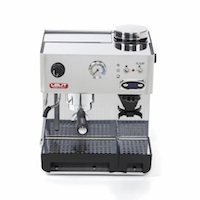
Many companies manufacture combination machines. In general, we recommend against them. Coffee beans are best kept cool and should the grinder or machine section fail, there is no way to make coffee at all.
Ok, so how much will I need to spend?
Budget will be dictated by the planned use of the machine and how many people will be using it:
Singles or couples. Primarily espresso/long black with occasional milk coffee. Never more than 2-4 coffees in a session.
Price range >$1000: Single boiler machine
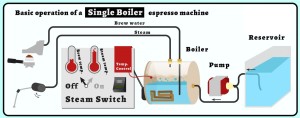
For this type of use, a single boiler machine might suffice. Single boiler machines will produce an espresso and if milky coffee is required, the user then pushes a button to further heat the boiler to produce the steam required to texture the milk. At this point, the boiler may well be empty and the element is hot. These machines do not have an internal control board or “brain” and if the steam control is left on, the element may fail and require replacement. To remove the risk of element failure, some of these machines require boiler priming before use and immediately after milk texture.
In single boiler machines such as the Rancilio Silvia, boiler temperature is controlled by a simple and cheap bimetallic strip thermostat. As the temperature of the espresso can vary substantially, a cooling flush or “temperature surfing” is often required to achieve consistent espresso. Times have moved on and there are better options available now.
More precise temperature control and a “brain” can be achieved along with a rapid heat ring group and PID as employed in the gorgeous Profitec Go which is our recommended best buy in this class. If you prefer an e-61 group, the La Pavoni Cellini Mini is a well-built, robust example.
Due to the many limitations of these machines, we do not in general recommend this style of machine for untrained novices, offices, busy families or heavy milk drinkers. These machines can however produce great coffee in the hands of a careful and/or advanced user.
Price range circa $1000-1300 or more: Baby Leva machine
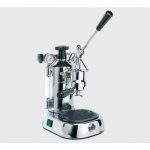 In this price range, La Pavoni produce some gorgeous little piston leva machines. These ar
In this price range, La Pavoni produce some gorgeous little piston leva machines. These ar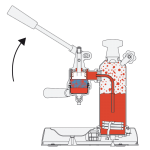 e great for a couple of coffees but if left on, will ultimately run hot. Allow a 10 minute warmup and then enjoy the amazing espresso they produce! After about 3 coffees, you will need to switch off for a while to allow the machine to cool. Milk texture performance is adequate, but they can be a little slow.
e great for a couple of coffees but if left on, will ultimately run hot. Allow a 10 minute warmup and then enjoy the amazing espresso they produce! After about 3 coffees, you will need to switch off for a while to allow the machine to cool. Milk texture performance is adequate, but they can be a little slow.
Whilst we don’t actively range La Pavoni Levas, we can source them in a day or two on request.
Families, offices, singles. Primarily espresso/long black with higher requirements for milk coffee. At times, more than 4 coffees per session- dinner parties etc: Heat Exchanger (HX) machine.
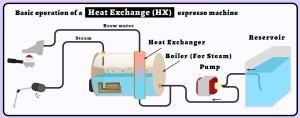 Heat exchanger machines offer the true “cafe at home” experience. They have the ability to produce espresso and texture milk simultaneously. Heat Exchanger machines will cater easily for families, gatherings and offices. All have water tanks of over 2 litres and more expensive models have commercial rotary pumps. Machines with rotary pumps are quieter in operation and may be plumbed to mains water connections if required. HX machines may be operated by simply raising or lowering a lever or with a simple toggle switch or rocker switches. Some HX machines have volumetric buttons to deliver a predetermined shot length. Volumetric machines can carry a price premium of up to $500 over non volumetric machines from the same range.
Heat exchanger machines offer the true “cafe at home” experience. They have the ability to produce espresso and texture milk simultaneously. Heat Exchanger machines will cater easily for families, gatherings and offices. All have water tanks of over 2 litres and more expensive models have commercial rotary pumps. Machines with rotary pumps are quieter in operation and may be plumbed to mains water connections if required. HX machines may be operated by simply raising or lowering a lever or with a simple toggle switch or rocker switches. Some HX machines have volumetric buttons to deliver a predetermined shot length. Volumetric machines can carry a price premium of up to $500 over non volumetric machines from the same range.
Price range circa $2.5k and beyond. Entry level heat exchanger (HX) machine.
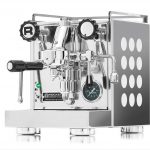 You’re spoilt for choice! Machines in this category will cater for any size gathering but operate only from their internal water tank which must be refilled. Amongst them are aimple “analogue” machines and more sophisticated examples with shot timers, PIDs, preinfusion control as well as rapid heat examples. This group have simple vibration pumps and cannot be plumbed to a mains connection. Examples include the ECM Mechanica Slim, *ECM Mechanica Slim Digital PID, Profitec Pro 400, *Profitec Pro 500, Profitec Jump, Izzo Vivi PID, Rocket Espresso Appartamento OG or Appartamento TCA as well as the Rocket Espresso Giotto Cronometro Tipo V and Mozzafiato Cronometro Tipo V.
You’re spoilt for choice! Machines in this category will cater for any size gathering but operate only from their internal water tank which must be refilled. Amongst them are aimple “analogue” machines and more sophisticated examples with shot timers, PIDs, preinfusion control as well as rapid heat examples. This group have simple vibration pumps and cannot be plumbed to a mains connection. Examples include the ECM Mechanica Slim, *ECM Mechanica Slim Digital PID, Profitec Pro 400, *Profitec Pro 500, Profitec Jump, Izzo Vivi PID, Rocket Espresso Appartamento OG or Appartamento TCA as well as the Rocket Espresso Giotto Cronometro Tipo V and Mozzafiato Cronometro Tipo V.
*Our recommended best buys in this class
PID in a HX machine?
Many who are looking for an espresso machine read about PID controlled espresso machines. A PID will in general make little difference to the performance of HX machines and referring to the diagram above delivers the answer as to why. HX machine groups receive what is essentially flash heated water from a tube in the boiler. Using a PID to alter the boiler temperature up or down by a few degrees will make little, if any difference at the group. There can be bonuses though: In the more sophisticated examples with more complex electronics: Control of boiler pressure, ECO modes, switchable preinfusion modes and rapid heating ring groups are found in various examples. A PID may work best in a multi-boiler machine where it can be used to deliver real differences in brew temperature. The ability to “play” with brew temperature can be significant to those with great palates who are into black coffee/espresso. A change to brew temperature can be difficult to distinguish in milky coffees.
I read about cooling flush in a HX machine?
Time to visit the dress up wardrobe for some ye olde clothing when this point is raised. Here’s why…
In olden days (and still in some areas of Italy), espresso blends often contained a very high percentage of robusta beans. These high robusta coffees may require a high extraction temperature (up to 96 or more deg. C) and Italian machines were manufactured to “run hot” to get the best from these coffees. Our Australian coffees tend to be low in robusta coffee or 100% arabica coffee. In general, medium roasts work well at lower temperatures; 92-94 deg. C is commonly recommended. As a result, Australian buyers of older Italian machines suffered with burned shots or flushed water through the group to achieve a cooling flush.
These days, reputable Australian importers have their HX espresso machines configured to idle in that ideal 92-94 deg. C range. The nett result is that you rinse the group (good hygiene) and simply use the machine.
There are still some imports of hot running HX machines into Australia. Talk Coffee will not sell poorly configured machines. It’s another reason why it’s not advisable to purchase a seat for a European sourced machine on your flight home after your trip to the continent. You also have no warranty or after sales support.
Price range circa $4k: Upper level HX machine.
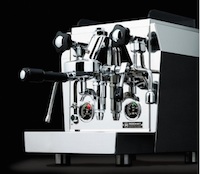 Machines in this category will also cater for any size gathering and can generally operate from their internal water tank or be plumbed into a mains connection. They have commercial rotary pumps and are much quieter in operation. The Izzo Alex PID, Rocket Espresso Giotto Cronometro Evoluzione R and Mozzafiato Cronometro Evoluzione R and ECM Mechanica Max (our pick of this in this class) are all popular examples.
Machines in this category will also cater for any size gathering and can generally operate from their internal water tank or be plumbed into a mains connection. They have commercial rotary pumps and are much quieter in operation. The Izzo Alex PID, Rocket Espresso Giotto Cronometro Evoluzione R and Mozzafiato Cronometro Evoluzione R and ECM Mechanica Max (our pick of this in this class) are all popular examples.
Advanced User. Price range $4k+ Those users requiring maximum control over espresso quality: Dual boiler machine.
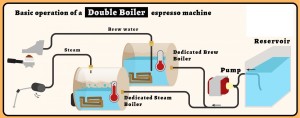
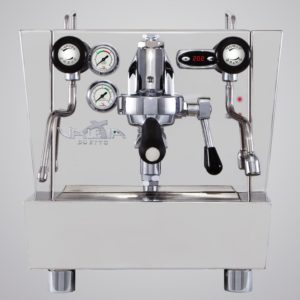
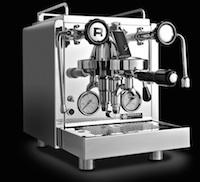 These machines offer ultimate control and flexibility. Most are classified as small commercial machines although they can be quite compact. They generally have rotary pumps and can be plumbed or run from an internal water tank. All have PID control of shot temperature and this can be useful for black coffee drinkers who like to experiment with roast depth and new “third wave” light roast coffees in pursuit of fruit notes and flavour. Most offer low energy modes where the steam boiler can be powered down if not required. Popular e-61 examples include the Rocket Espresso R Cinquantotto, Profitec Pro 600, the Izzo Alex Duetto. The Profitec Drive and Move are rapid to heat examples worth considering. Our pick in this class is the ECM Synchronica II for overall build quality, rapid heating and functionality. The forthcoming Profitec Ride will will also deliver rapid heating and excellent functionality for those not require ing a rotary pump machine.
These machines offer ultimate control and flexibility. Most are classified as small commercial machines although they can be quite compact. They generally have rotary pumps and can be plumbed or run from an internal water tank. All have PID control of shot temperature and this can be useful for black coffee drinkers who like to experiment with roast depth and new “third wave” light roast coffees in pursuit of fruit notes and flavour. Most offer low energy modes where the steam boiler can be powered down if not required. Popular e-61 examples include the Rocket Espresso R Cinquantotto, Profitec Pro 600, the Izzo Alex Duetto. The Profitec Drive and Move are rapid to heat examples worth considering. Our pick in this class is the ECM Synchronica II for overall build quality, rapid heating and functionality. The forthcoming Profitec Ride will will also deliver rapid heating and excellent functionality for those not require ing a rotary pump machine.
The purist- Advanced skills and looking to produce exceptional coffee. Price range >$5000
Lever pull machines:
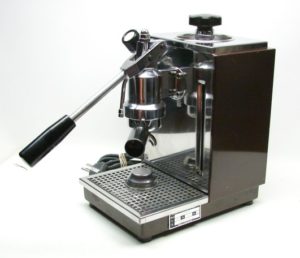
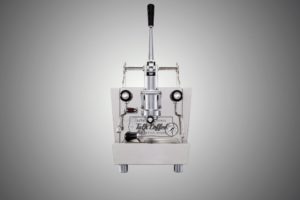 What’s old is new again with these machines. They are silent as there is no pump. As a result, they require a mains connection. Shot quality is outstanding as the waning pressure profile minimises the likelihood of unpleasant tertiary extraction in the espresso shot. Many of our clients purchase a variety of espresso machines and then ultimately settle on a lever machine- forever. The romance and beauty of these machines combines with some of the best espresso possible. They are in a nutshell, coffee nirvana. Examples include the ACS Vesuvius EVO, Profitec Pro 800 and Izzo Alex/Valexia Leva. The Olympia Express Cremina and Cremina SL20 offer an incredible quality, but expensive Swiss manufactured alternative to the much larger spring lever machines. All examples are excellent.
What’s old is new again with these machines. They are silent as there is no pump. As a result, they require a mains connection. Shot quality is outstanding as the waning pressure profile minimises the likelihood of unpleasant tertiary extraction in the espresso shot. Many of our clients purchase a variety of espresso machines and then ultimately settle on a lever machine- forever. The romance and beauty of these machines combines with some of the best espresso possible. They are in a nutshell, coffee nirvana. Examples include the ACS Vesuvius EVO, Profitec Pro 800 and Izzo Alex/Valexia Leva. The Olympia Express Cremina and Cremina SL20 offer an incredible quality, but expensive Swiss manufactured alternative to the much larger spring lever machines. All examples are excellent.
Pressure profiling/Flow profiling machines. $$$$$
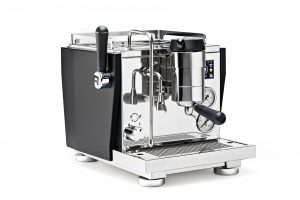 Pressure profiling machines have the ability to vary extraction pressure within a shot can and bring out the absolute best attributes of any coffee. Rocket Espresso are in this market with their incredible and versatile R NINE ONE (our pick in this class) as is San Remo with their You.
Pressure profiling machines have the ability to vary extraction pressure within a shot can and bring out the absolute best attributes of any coffee. Rocket Espresso are in this market with their incredible and versatile R NINE ONE (our pick in this class) as is San Remo with their You.